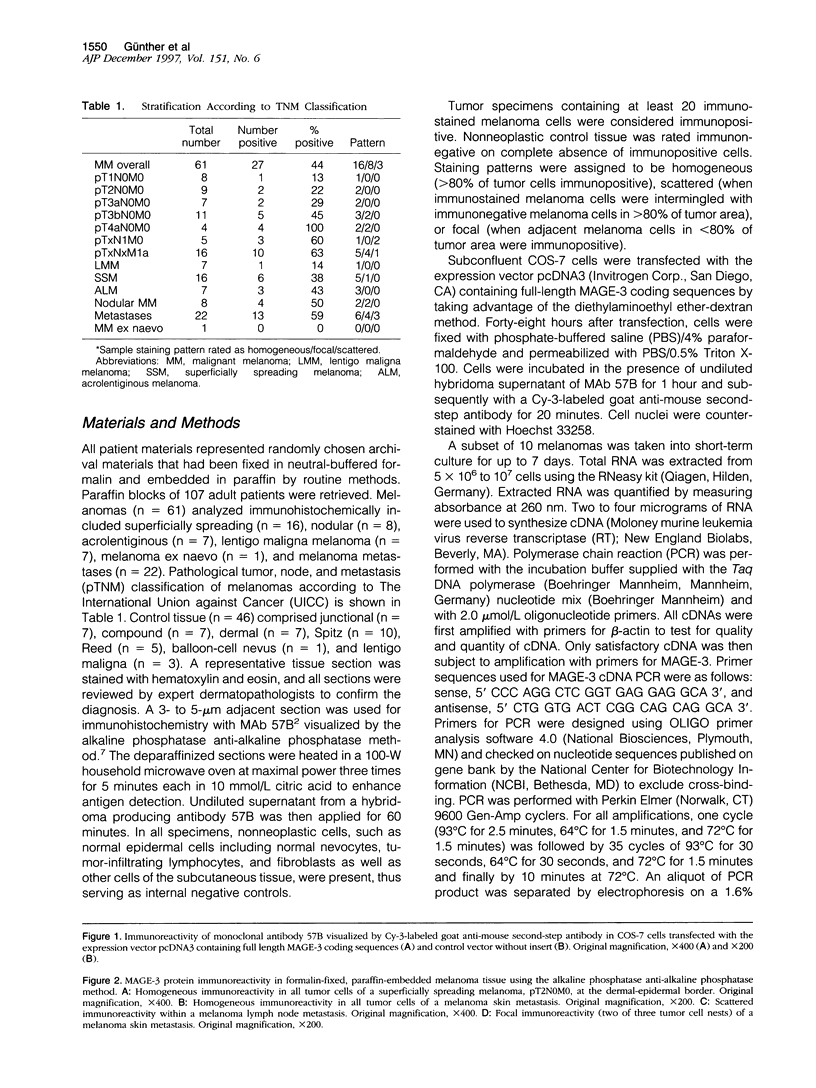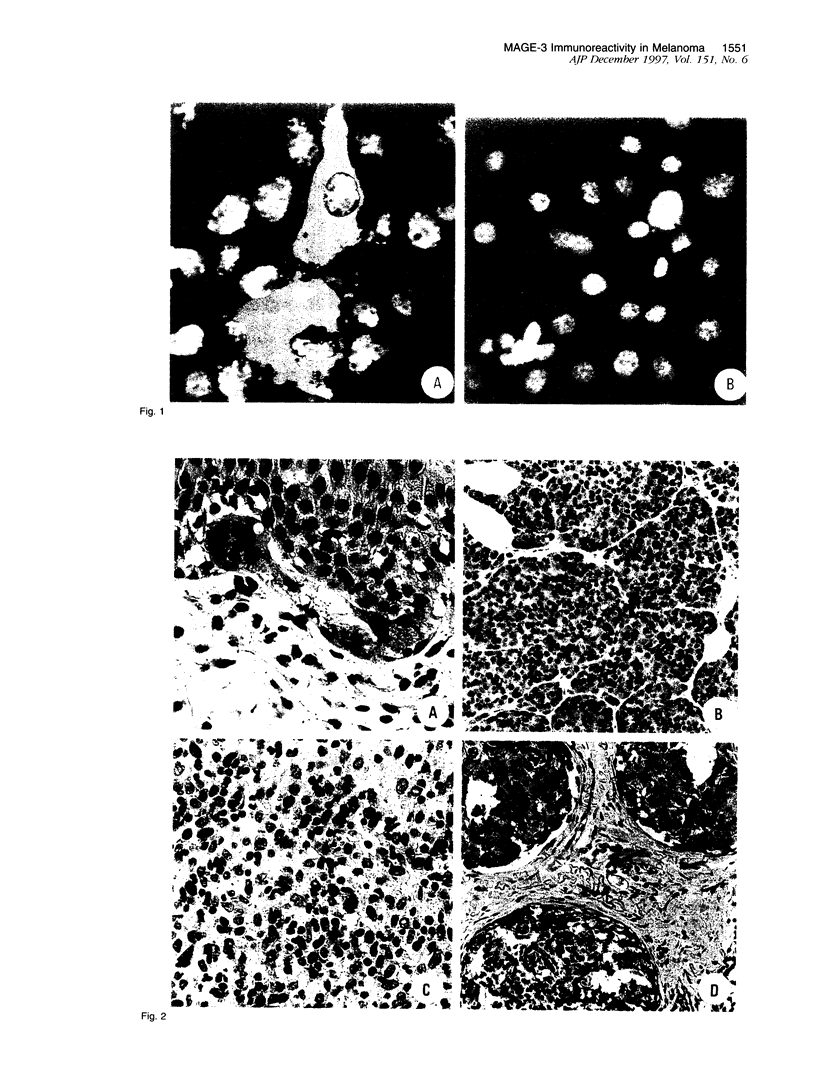Abstract
Monoclonal antibody 57B specifically detects MAGE-3 gene protein expression. MAGE-derived peptides are recognized by CD8+ T cells and applied in immunotherapy. We examined formalin-fixed, paraffin-embedded tissue of 61 melanoma (primary, n = 40; metastatic, n = 21) and 46 control cases (junctional, dermal, compound, Spitz, Reed, and balloon-cell nevi) by immunohistochemistry using the alkaline phosphatase anti-alkaline phosphatase method after antigen retrieval. Immunoreactivity was rated positive at 20 positive cells per tumor or more. Staining pattern was homogeneous, scattered, or focal. All control samples and internal controls were immunonegative. Staining with monoclonal antibody 57B showed a specificity of 100% with a sensitivity of 44%. Immunopositivity (overall, 44% of melanomas) increased along with tumor, node, and metastasis stage; pT1 showed 13%, pT2 22%, pT3a 29%, pT3b 45%, pT4 100%, pTxN1 60%, and pTxNxM1a 63% of samples positive. The staining pattern was homogeneous on pT1 to pT3a tumors, homogeneous or focal in pT3b and pT4a, and homogeneous, focal, or scattered in pTxN1 and pTxNxM1a. The frequency of immunopositivity relates well to data on mRNA expression using reverse transcriptase polymerase chain reaction in a subgroup analyzed by both methods. Monoclonal antibody 57B can be used to allow profiling of melanomas using routine archival tissue, when considering immunotherapeutic approaches involving MAGE-3-derived epitopes.
Full text
PDF




Images in this article
Selected References
These references are in PubMed. This may not be the complete list of references from this article.
- Albino A. P., Fountain J. W. Molecular genetics of human malignant melanoma. Cancer Treat Res. 1993;65:201–255. doi: 10.1007/978-1-4615-3080-0_8. [DOI] [PubMed] [Google Scholar]
- Boon T., van der Bruggen P. Human tumor antigens recognized by T lymphocytes. J Exp Med. 1996 Mar 1;183(3):725–729. doi: 10.1084/jem.183.3.725. [DOI] [PMC free article] [PubMed] [Google Scholar]
- Brasseur F., Rimoldi D., Liénard D., Lethé B., Carrel S., Arienti F., Suter L., Vanwijck R., Bourlond A., Humblet Y. Expression of MAGE genes in primary and metastatic cutaneous melanoma. Int J Cancer. 1995 Nov 3;63(3):375–380. doi: 10.1002/ijc.2910630313. [DOI] [PubMed] [Google Scholar]
- Büeler H., Mulligan R. C. Induction of antigen-specific tumor immunity by genetic and cellular vaccines against MAGE: enhanced tumor protection by coexpression of granulocyte-macrophage colony-stimulating factor and B7-1. Mol Med. 1996 Sep;2(5):545–555. [PMC free article] [PubMed] [Google Scholar]
- Celis E., Tsai V., Crimi C., DeMars R., Wentworth P. A., Chesnut R. W., Grey H. M., Sette A., Serra H. M. Induction of anti-tumor cytotoxic T lymphocytes in normal humans using primary cultures and synthetic peptide epitopes. Proc Natl Acad Sci U S A. 1994 Mar 15;91(6):2105–2109. doi: 10.1073/pnas.91.6.2105. [DOI] [PMC free article] [PubMed] [Google Scholar]
- Cordell J. L., Falini B., Erber W. N., Ghosh A. K., Abdulaziz Z., MacDonald S., Pulford K. A., Stein H., Mason D. Y. Immunoenzymatic labeling of monoclonal antibodies using immune complexes of alkaline phosphatase and monoclonal anti-alkaline phosphatase (APAAP complexes). J Histochem Cytochem. 1984 Feb;32(2):219–229. doi: 10.1177/32.2.6198355. [DOI] [PubMed] [Google Scholar]
- Corrias M. V., Scaruffi P., Occhino M., De Bernardi B., Tonini G. P., Pistoia V. Expression of MAGE-1, MAGE-3 and MART-1 genes in neuroblastoma. Int J Cancer. 1996 Oct 21;69(5):403–407. doi: 10.1002/(SICI)1097-0215(19961021)69:5<403::AID-IJC9>3.0.CO;2-9. [DOI] [PubMed] [Google Scholar]
- Dummer R., Davis-Daneshfar A., Döhring C., Döbbeling U., Burg G. Strategien zur Gentherapie des Melanoms. Hautarzt. 1995 May;46(5):305–308. doi: 10.1007/s001050050256. [DOI] [PubMed] [Google Scholar]
- Fleischhauer K., Fruci D., Van Endert P., Herman J., Tanzarella S., Wallny H. J., Coulie P., Bordignon C., Traversari C. Characterization of antigenic peptides presented by HLA-B44 molecules on tumor cells expressing the gene MAGE-3. Int J Cancer. 1996 Nov 27;68(5):622–628. doi: 10.1002/(SICI)1097-0215(19961127)68:5<622::AID-IJC12>3.0.CO;2-3. [DOI] [PubMed] [Google Scholar]
- Gattoni-Celli S., Cole D. J. Melanoma-associated tumor antigens and their clinical relevance to immunotherapy. Semin Oncol. 1996 Dec;23(6):754–758. [PubMed] [Google Scholar]
- Gaugler B., Van den Eynde B., van der Bruggen P., Romero P., Gaforio J. J., De Plaen E., Lethé B., Brasseur F., Boon T. Human gene MAGE-3 codes for an antigen recognized on a melanoma by autologous cytolytic T lymphocytes. J Exp Med. 1994 Mar 1;179(3):921–930. doi: 10.1084/jem.179.3.921. [DOI] [PMC free article] [PubMed] [Google Scholar]
- Hu X., Chakraborty N. G., Sporn J. R., Kurtzman S. H., Ergin M. T., Mukherji B. Enhancement of cytolytic T lymphocyte precursor frequency in melanoma patients following immunization with the MAGE-1 peptide loaded antigen presenting cell-based vaccine. Cancer Res. 1996 Jun 1;56(11):2479–2483. [PubMed] [Google Scholar]
- Itoh K., Hayashi A., Nakao M., Hoshino T., Seki N., Shichijo S. Human tumor rejection antigens MAGE. J Biochem. 1996 Mar;119(3):385–390. doi: 10.1093/oxfordjournals.jbchem.a021252. [DOI] [PubMed] [Google Scholar]
- Kocher T., Schultz-Thater E., Gudat F., Schaefer C., Casorati G., Juretic A., Willimann T., Harder F., Heberer M., Spagnoli G. C. Identification and intracellular location of MAGE-3 gene product. Cancer Res. 1995 Jun 1;55(11):2236–2239. [PubMed] [Google Scholar]
- Maeurer M. J., Storkus W. J., Kirkwood J. M., Lotze M. T. New treatment options for patients with melanoma: review of melanoma-derived T-cell epitope-based peptide vaccines. Melanoma Res. 1996 Feb;6(1):11–24. doi: 10.1097/00008390-199602000-00003. [DOI] [PubMed] [Google Scholar]
- Marchand M., Weynants P., Rankin E., Arienti F., Belli F., Parmiani G., Cascinelli N., Bourlond A., Vanwijck R., Humblet Y. Tumor regression responses in melanoma patients treated with a peptide encoded by gene MAGE-3. Int J Cancer. 1995 Dec 11;63(6):883–885. doi: 10.1002/ijc.2910630622. [DOI] [PubMed] [Google Scholar]
- Mori M., Inoue H., Mimori K., Shibuta K., Baba K., Nakashima H., Haraguchi M., Tsuji K., Ueo H., Barnard G. F. Expression of MAGE genes in human colorectal carcinoma. Ann Surg. 1996 Aug;224(2):183–188. doi: 10.1097/00000658-199608000-00011. [DOI] [PMC free article] [PubMed] [Google Scholar]
- Rosenberg S. A. The immunotherapy of solid cancers based on cloning the genes encoding tumor-rejection antigens. Annu Rev Med. 1996;47:481–491. doi: 10.1146/annurev.med.47.1.481. [DOI] [PubMed] [Google Scholar]
- Van den Eynde B., Peeters O., De Backer O., Gaugler B., Lucas S., Boon T. A new family of genes coding for an antigen recognized by autologous cytolytic T lymphocytes on a human melanoma. J Exp Med. 1995 Sep 1;182(3):689–698. doi: 10.1084/jem.182.3.689. [DOI] [PMC free article] [PubMed] [Google Scholar]
- van der Bruggen P., Bastin J., Gajewski T., Coulie P. G., Boël P., De Smet C., Traversari C., Townsend A., Boon T. A peptide encoded by human gene MAGE-3 and presented by HLA-A2 induces cytolytic T lymphocytes that recognize tumor cells expressing MAGE-3. Eur J Immunol. 1994 Dec;24(12):3038–3043. doi: 10.1002/eji.1830241218. [DOI] [PubMed] [Google Scholar]





